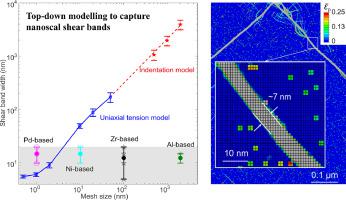当前位置:
X-MOL 学术
›
J. Mech. Phys. Solids
›
论文详情
Our official English website, www.x-mol.net, welcomes your feedback! (Note: you will need to create a separate account there.)
Top-down constitutive modelling to capture nanoscale shear localization
Journal of the Mechanics and Physics of Solids ( IF 5.3 ) Pub Date : 2024-03-23 , DOI: 10.1016/j.jmps.2024.105629 Jici Wen , Yujie Wei
Journal of the Mechanics and Physics of Solids ( IF 5.3 ) Pub Date : 2024-03-23 , DOI: 10.1016/j.jmps.2024.105629 Jici Wen , Yujie Wei

|
Deformation localization as exemplified by earthquakes, landslides, shear banding in solids, and failure of engineering components is of utmost importance. In practice, differentiating the mechanical behavior in such generative narrow bands from the rest part, with difference by orders of magnitude in characteristic size, flow strength, temperature, and shearing rate, is both experimentally and computationally formidable. Here we propose a machine-learning-based constitutive modeling framework to overcome this barrier borne from conventional top-down continuum modelling approach. The model enables us to realize ultra-fine resolutions for deformation in those narrow bands with high efficiency. Taking metallic glasses (MGs) as an example, our model captures well shear localization in BMGs across a broad range of temperatures (0 K to its melting point of ∼1000 K) and strain rates ( to ). We verify through this model the width of shear bands (SBs) in MGs is on the order of 5–8 nanometers, which is resulted from a cascade of (intervening) events, from localized shearing to plastic heating, subsequent temperature rise to thermal softening, and accelerated flow rate to strain-rate hardening. Temperature rise in SBs is a resultant of heat flow and plastic dissipation, but strongly depend on thermal conductivity: Low thermal conductivity facilitates strain localization and great temperature rise. It helps understanding the current controversy upon experimentally measured temperature rise ranging from several K to ∼1000 K. Lastly, strain rates within SBs are approximately one to two orders of magnitude higher than externally applied strain rates, and in general shearing in adiabatic SBs is faster than that in isothermal condition.
中文翻译:

自上而下的本构建模以捕获纳米级剪切定位
以地震、山体滑坡、固体剪切带和工程部件失效为例的变形局部化至关重要。在实践中,将这种生成窄带中的机械行为与其余部分区分开来,在特征尺寸、流动强度、温度和剪切速率方面存在数量级的差异,在实验和计算上都是艰巨的。在这里,我们提出了一种基于机器学习的本构建模框架,以克服传统自上而下的连续体建模方法所带来的障碍。该模型使我们能够高效地实现窄带变形的超精细分辨率。以金属玻璃 (MG) 为例,我们的模型在较宽的温度范围(0 K 至其熔点 ∼1000 K)和应变率 ( 至 ) 内捕获了 BMG 中良好的剪切局部化。我们通过这个模型验证了 MG 中的剪切带 (SB) 宽度约为 5-8 纳米,这是由一系列(干预)事件导致的,从局部剪切到塑料加热,随后温度升高到热软化,并加速流速以进行应变率硬化。 SB 中的温升是热流和塑性耗散的结果,但很大程度上取决于热导率:低热导率有利于应变局部化和大幅温升。它有助于理解当前关于实验测量的温升范围从几 K 到~1000 K 的争议。最后,SB 内的应变率大约比外部施加的应变率高一到两个数量级,并且一般来说,绝热 SB 中的剪切速度更快与等温条件下相比。
更新日期:2024-03-23
中文翻译:

自上而下的本构建模以捕获纳米级剪切定位
以地震、山体滑坡、固体剪切带和工程部件失效为例的变形局部化至关重要。在实践中,将这种生成窄带中的机械行为与其余部分区分开来,在特征尺寸、流动强度、温度和剪切速率方面存在数量级的差异,在实验和计算上都是艰巨的。在这里,我们提出了一种基于机器学习的本构建模框架,以克服传统自上而下的连续体建模方法所带来的障碍。该模型使我们能够高效地实现窄带变形的超精细分辨率。以金属玻璃 (MG) 为例,我们的模型在较宽的温度范围(0 K 至其熔点 ∼1000 K)和应变率 ( 至 ) 内捕获了 BMG 中良好的剪切局部化。我们通过这个模型验证了 MG 中的剪切带 (SB) 宽度约为 5-8 纳米,这是由一系列(干预)事件导致的,从局部剪切到塑料加热,随后温度升高到热软化,并加速流速以进行应变率硬化。 SB 中的温升是热流和塑性耗散的结果,但很大程度上取决于热导率:低热导率有利于应变局部化和大幅温升。它有助于理解当前关于实验测量的温升范围从几 K 到~1000 K 的争议。最后,SB 内的应变率大约比外部施加的应变率高一到两个数量级,并且一般来说,绝热 SB 中的剪切速度更快与等温条件下相比。



























 京公网安备 11010802027423号
京公网安备 11010802027423号